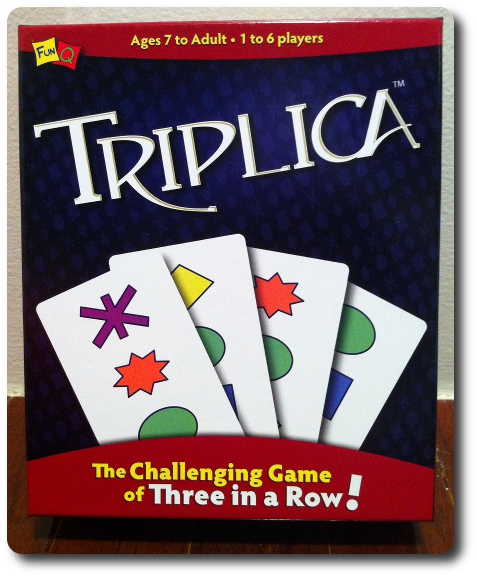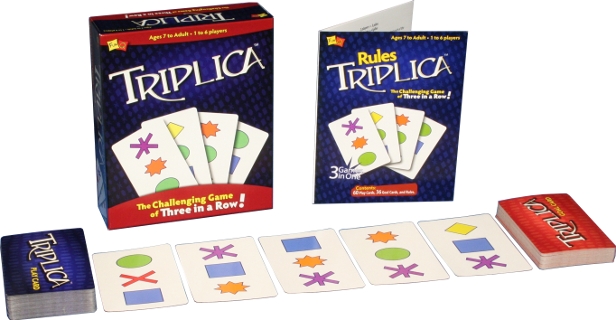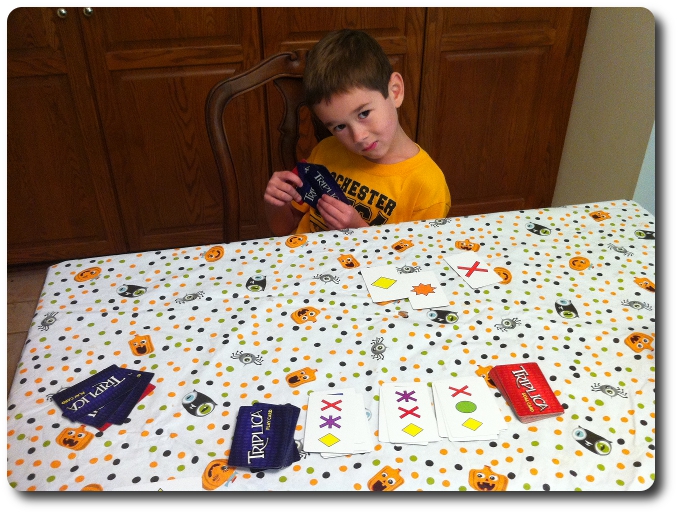
The Basics:
- For ages 7 and up
- For 1 to 6 players
- About 15 minutes to complete
Geek Skills:
- Counting & Math
- Logical & Critical Decision Making
- Pattern/Color Matching
- Strategy & Tactics
- Hand/Resource Management
Learning Curve:
- Child – Easy
- Adult – Easy
Theme & Narrative:
- None
Endorsements:
- Gamer Geek rejected!
- Parent Geek approved!
- Child Geek approved!
Overview
In Triplica, the player is attempting to match 3 symbols in a row or diagonally to match their Goal cards to gain points. Cards overlay one another creating an ever-changing play space where the players must constantly be on their toes to keep their head in the game and their goal in site! The end result is a fun, fast, and challenging card game that can be played by the whole family or solo.
Triplica is comprised of 60 Play cards and 36 Goal cards for a total of 96 cards. The Goal cards have one of possible six shapes on them. The Play cards have a random assortment of 3 of the shapes. The cards are clearly labeled on the back and different colors which will make separating them a quick and painless exercise. The cards are printed on good quality, durable card stock with a glossy finish. All in all, an excellent product.
Game Set up
As you can imagine, game set up is pretty straight forward but is slightly different depending on which of the three game types you are going to play and the number of players available to play the game with. Suffice to say, it all starts with dividing the Goal and Play cards into two decks and shuffling each thoroughly. All that remains is determining which game type you want to enjoy.
Throughout the game there are up to 3 different groupings of cards. These are the Goal card deck, the Play card deck, and the Play Pile. The Goal and Play card decks are fairly self-explanatory. The Play Pile is where the players place one Play card on top of an already played cards. All cards in the Play Pile are face up and can be rotated 180 degrees by the player before being placed. Depending on the game type, the Goal card deck might or might not be used.

From left to right, the Play card deck, the Play Pile, and the Goal card deck. The game box and rule book are shown at rear.
The Universal Goal
Before we jump into the three game types, it is important to understand the universal goal of all the games. The goal is to match 3 of the shapes in a row or diagonally. When there is a match, this is referred to as a “triplica”. Depending on the number of players or the game being played, there very well could be up to five different piles in the row. However, the players never needs to match anymore than 3.
During the game, a card can be played that creates more than one triplica. A player can only score one triplica at a time, and depending on the game type being played, the same triplica or any unclaimed triplicas can be scored by the other players. Cards with the same shapes can also be played again and again to create the same triplica for scoring.
And speaking of scoring, it simply does not matter how many times a triplica is created by the player if they do not have a Goal card with a matching shape. The shape on the player’s Goal card must match the triplica in order to be counted for points. If not, the triplica goes unclaimed and play continues.
The universal goal is at the core of Triplica. The three different game types simply define the means to which the player’s attempt to score.
Speaking of the 3 game types…
Playing the Game: Solitaire
To play Triplica Solitaire, separate the Goal deck into six piles, one for each shape, and place to one side, face-up. Next, deal 4 Play cards face-up in a row to start the Play Piles. Place the Play card deck, face-down, to one side. You are now ready to play Triplica, solitaire style!
Draw one card from the Play deck and attempt to place it to score a triplica. If a triplica is scored, remove the shape from the appropriate Goal card pile. Place this Goal card aside until the end of the game. Continue to play until all the cards of the Play card deck have been dealt to one of the four Play Piles or all the Goal cards have been collected. You must always place the Play card in the Play Pile, even if it does not create a triplica.
The player’s goal is to obtained as many of the 36 Goal cards as possible by scoring triplicas before they run out of Play cards. The player’s score is equal to the number of Play cards remaining in the Play card deck.
Playing the Game – Single Play
To play Triplica Single Play, deal out five Goal cards to each player. Players should pick up and review their Goal cards, making certain that they keep them hidden from the other players. The rest of the Goal cards can be set aside and are not used for the duration of the game.
The number of Play Piles is based on the number of players, ranging from 3 piles for a two-player game to 5 piles for a five to six player game. Deal one Play card for each Play Pile, face-up, in a row.
On a player’s turn, they draw one Play cards from the deck and place it on one of the Play Piles. If the placed card creates a triplica, the player should immediately score it. Only one goal for each shape can be scored at a time. Scored goals must be revealed to all the other players and are placed face-up in front of the player until the end of the game.
If a triplica is created and not scored, it can be claimed by the next player. To do so, the player skips their normal turn sequence and simply scores the triplica.
The first player to score all five of their Goals is the winner. If the Play Pile is exhausted before a player has won, gather all the Play cards, shuffle, and deal a new row to create the Play Pile.
Playing the Game – All Play
To play Triplica All Play, deal one Goal card, face-down, to each player. Players should pick up and review their Goal cards, making certain that they keep them hidden from the other players. The Goal deck is placed to one side of the game play area and within easy reach of all players.
Deal out 3 Play cards to each player, face-down. Like the Goal cards, players should pick up and review their Play cards, making certain that they keep them hidden from the other players. The Play deck is placed to one side of the game play area and within easy reach of all players.
The number of Play Piles is based on the number of players, ranging from 3 piles for a two-player game to 5 piles for a five to six player game. Deal one Play card for each Play Pile, face-up, in a row.
On a player’s turn, they place one of their Play cards in their hand onto one of the Play Piles in an attempt to create a triplica that matches their Goal card. If a triplica is created, then all players can score off it immediately. Scored goals must be revealed to all the other players and are placed face-up in front of the player until the end of the game. All players who scored their goal should immediately draw a new Goal card. The player’s turn ends when they draw a new Play card.
The first player to score 5 goals wins the game. If two or more players score their fifth Goal at the same time, and one of the players is the one who placed the Play card to create the triplica, they break and win the tie. If two or more players score their fifth Goal at the same time, and none of the players is the one who placed the Play card to create the triplica, the player who declared the triplica first breaks the tie and wins.
Prediction
Card games continue to be the most frequent game type requested by my little geeks and by family friends. There is just something about card games that immediately puts a player at ease, which makes the game more accessible and enjoyable. This is most likely because we have all had experience with card games at one time in our lives and our minds can immediately make a connection with the medium in which the game is played.
For my little geeks, I think they enjoy card games so much because of how fast they are to take out, set up, play, and then clean up. As a father of three who is constantly picking up toys and books around the house, having a game that is so easily packed away is a genuine treat.
My two oldest little geeks were both very excited to play the game, but they first wanted to just play with the cards and look them over. I cannot stress enough how important it is that you allow your little geeks to do this. This gives them time to familiarize themselves with the game, ask questions, and learn the rules at an easy pace. At first, I simply sat my little geeks down with the game already set up to demonstrate. This was like bringing my little geeks into a conversation that was already started. I spent more time back tracking then going forward with the game. Ever since I started by letting them open the box and dump the components out, our game playing has become much smoother and, strangely enough, faster.
After I explained the universal rule of the game, I then explained the three different game types, making certain to always bring up the universal rule least they forget. Both boys caught on to what was required which is both a testament to how easy the game play is and how well designed the game is, too.
We decided to play Single Play so as to allow each player the time they needed to place their cards. While I shuffled the decks, dealt the cards, and placed the Play Pile, I asked my little geeks what they thought of the game so far.
“This is very cool. It’s like Tic-Tac-Toe but with cards and more interesting.” ~ Liam (age 7)
“I like the Ninja Stars and the other shapes!” ~ Nyhus (age 4)
Ninja Stars and Tic-Tac-Toe! Now why didn’t the game publishers put that on the box?
Final Word
As expected, Triplica was an absolute success with my little geeks. They did surprisingly well for their first game and only got better the more times we played it. Before I knew it, they were scoring triplicas as fast as I was. They even stole triplicas from me! My 7-year-old played a much more strategic game than his younger brother, but Triplica allows even your youngest player to be as much a part of the game as the most experienced player. This made Triplica all the more entertaining and enjoyable as I as able to play the game as an equal with my sons. Just a bunch of geeks enjoying a lazy afternoon at the family gaming table. Marvelous!
My oldest liked the game so much and wants to play it so often, that I taught him the Solitaire rules of the game. He has found this to be a great deal of fun and challenging. This also allows him to play a game by himself when he wants quiet time or his younger brothers, Mom, and Dad are busy. As Triplica is his first “solitaire” game experience, we’ll have to see if this leads him to seek out other single-player games. I personally doubt it, as he is a social butterfly like his father.

My son's love of the game is only matched by his love of winning the game against his father - Kid already has 3 triplicas and I have zero! I've created a monster...
Gamer Geeks, as much as you are going to recognize Triplica as great game, you won’t be all that interested in it. The game play is simple and limited. There is no room for grandiose strategy or skill. Much is based on the luck of the draw and the limited hand management won’t keep your interest. At most, you’ll enjoy this as a quick and light game filler before you start getting into the heavier games.
Parent Geeks, you are going to love this game. Easy to play and even easier to teach. Colors and shapes are used to create a fun game to play with your family and non-gamer friends. There is limited depth to the game, much too limited for the gamer elitist, but for the casual game player who is looking for a fast and fun game that provides a good level of player interaction, Triplica is perfect. Here is a game that even your non-non-non-gamer friends will enjoy. Just don’t tell them it’s a game.
Child Geeks, put down those video games and grab yourself a box of Triplica! This is a fast, easy, and fun card game Child Geeks can play with their friends, by themselves, or with their family any night of the week! Child Geeks will immediately be able to pick up on the universal goal and able to master the game after only one session. As there are is nothing to read, Triplica is a game your youngest little geek can enjoy playing at the family gaming table with little to no help from their mom and dad. This will give them a huge confidence boost and encourage them to play more games and seek out new challenges.
Triplica also comes in a small box which makes it very portable and a great game to bring on family car trips, camping, or to a friend’s house. Teachers should also take note of this game as it promotes color and pattern matching and counting.
Light, fast, easy, and fun, Triplica is a game you will enjoy playing again and again at your family gaming table! To learn more about Triplica and review the many awards this game has earned, see the Fun Q Games web site.
This game was given to Father Geek as a review copy. Father Geek was not paid, bribed, wined, dined, or threatened in vain hopes of influencing this review. Such is the statuesque and legendary integrity of Father Geek.



